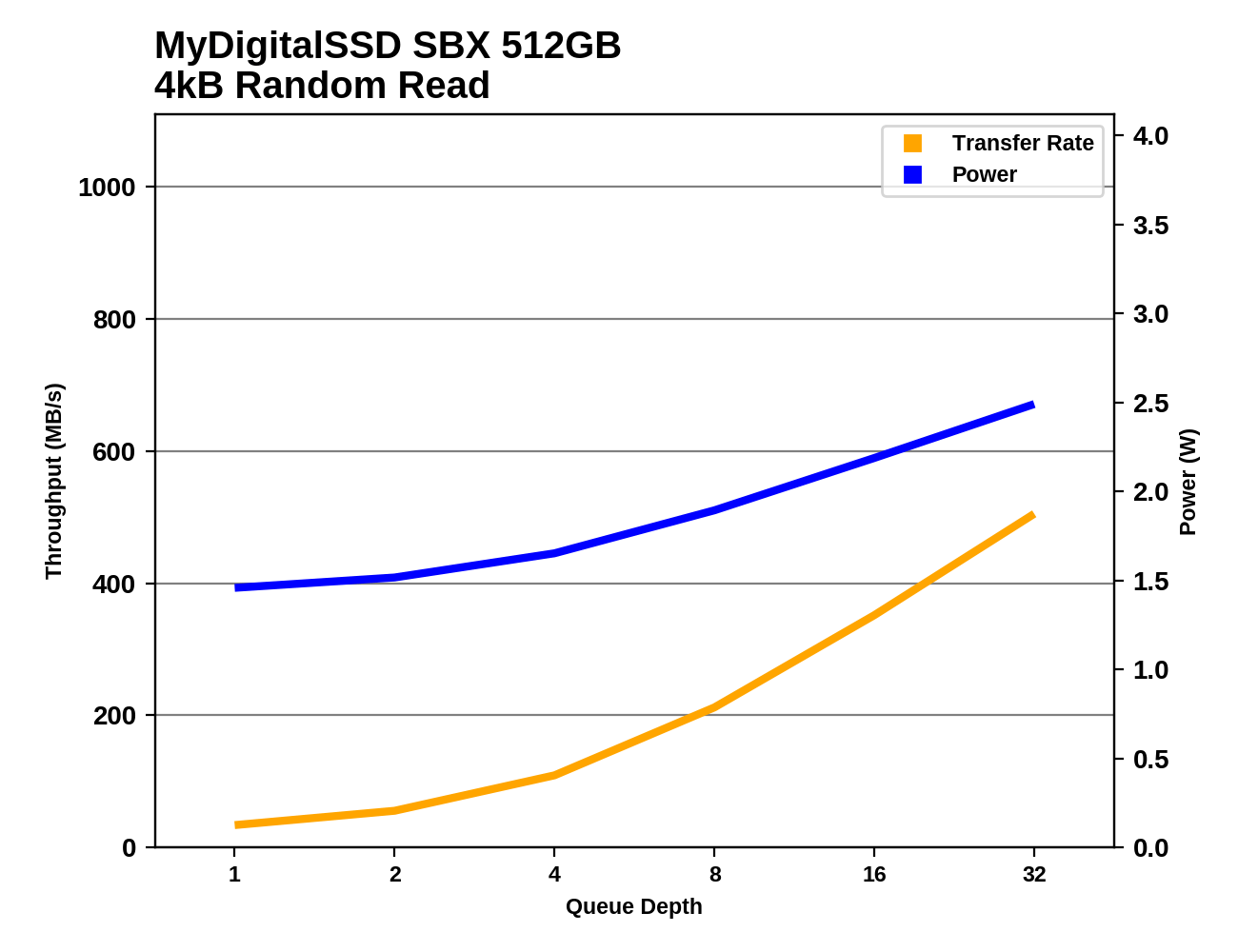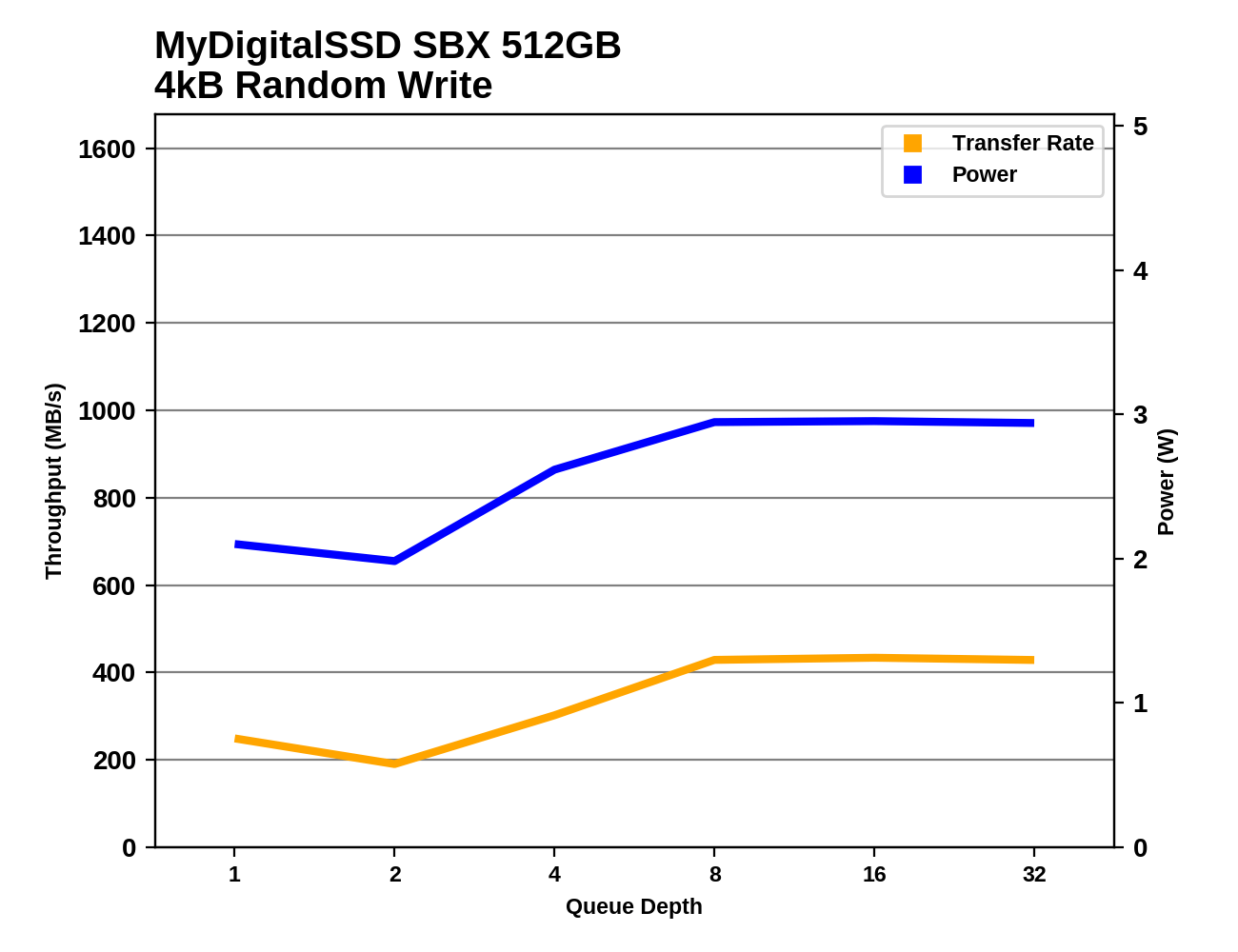The MyDigitalSSD SBX SSD Review: NVMe On The Cheap
by Billy Tallis on May 1, 2018 8:05 AM ESTRandom Read Performance
Our first test of random read performance uses very short bursts of operations issued one at a time with no queuing. The drives are given enough idle time between bursts to yield an overall duty cycle of 20%, so thermal throttling is impossible. Each burst consists of a total of 32MB of 4kB random reads, from a 16GB span of the disk. The total data read is 1GB.

The QD1 burst random read performance of the MyDigitalSSD SBX is relatively poor, falling behind the top tier of SATA SSDs. The SBX is faster than the Intel SSD 600p, but the newer Intel 760p is more than 50% faster than the SBX.
Our sustained random read performance is similar to the random read test from our 2015 test suite: queue depths from 1 to 32 are tested, and the average performance and power efficiency across QD1, QD2 and QD4 are reported as the primary scores. Each queue depth is tested for one minute or 32GB of data transferred, whichever is shorter. After each queue depth is tested, the drive is given up to one minute to cool off so that the higher queue depths are unlikely to be affected by accumulated heat build-up. The individual read operations are again 4kB, and cover a 64GB span of the drive.

The ranking of the MyDigitalSSD SBX doesn't change much on the longer random read test, but many of the faster drives have traded places. Even with some higher queue depths involved, the SBX can't quite match the best SATA SSDs for random read performance.
 |
|||||||||
| Power Efficiency in MB/s/W | Average Power in W | ||||||||
The MyDigitalSSD SBX draws substantially less power during the random read test than most NVMe SSDs, which leads to an efficiency score that is about average. Many of the SATA drives have a significant efficiency advantage, as do several of the fastest NVMe SSDs.
 |
|||||||||
The 512GB SBX clearly has room for further throughput increases past QD32, but the smaller capacities start falling behind past QD4 and are close to saturation by QD32. The Intel SSD 760p shows similar performance scaling that is almost always a bit faster than the SBX, but also requires significantly more power across the board.
Random Write Performance
Our test of random write burst performance is structured similarly to the random read burst test, but each burst is only 4MB and the total test length is 128MB. The 4kB random write operations are distributed over a 16GB span of the drive, and the operations are issued one at a time with no queuing.

The burst random write performance of the MyDigitalSSD SBX can't match the unusually good performance from the Intel SSD 760p, but it is certainly reasonable for a low-end NVMe SSD. The 128GB SBX is about 30% slower than the larger capacities, but is still faster than the SATA drives.
As with the sustained random read test, our sustained 4kB random write test runs for up to one minute or 32GB per queue depth, covering a 64GB span of the drive and giving the drive up to 1 minute of idle time between queue depths to allow for write caches to be flushed and for the drive to cool down.

On the longer random write test, SLC cache size limitations come into play and the 128GB drives end up near the bottom of the chart, above only the DRAMless SATA drives. The larger capacities aren't quite as fast as the top SATA SSDs, and the more expensive NVMe SSDs offer more than double the throughput of the SBX even at these relatively low queue depths.
 |
|||||||||
| Power Efficiency in MB/s/W | Average Power in W | ||||||||
The SBX is again using much less power than the other NVMe SSDs, but its poor performance leaves it with a fairly low efficiency score.
 |
|||||||||
Performance from the SBX drops during the early phases of the random write test as the SLC write cache is quickly filled. Only the 512GB model manages to recover performance later at high queue depths, but its eventual limit is not far above the performance offered by SATA drives.










46 Comments
View All Comments
dgingeri - Tuesday, May 1, 2018 - link
For $53 for a 128GB one, with a 5 year warranty? That's now the boot drive of my server.dgingeri - Monday, May 7, 2018 - link
It has worked remarkably well as a server boot drive. I highly recommend it.vailr - Tuesday, May 1, 2018 - link
An external USB 3.0 connected PCIe M.2 type NVMe adapter would be faster than any USB thumb drive, and would be ideal for a bootable external "Windows to Go". Is such a device available yet?Something like this: https://www.amazon.com/StarTech-com-M-2-SATA-SSD-E... but compatible with PCIe NVMe M.2 80mm drives, such as this MyDigitalSSD, or the Samsung 960 NVMe, for example.
MajGenRelativity - Tuesday, May 1, 2018 - link
The only ones I've seen are Thunderbolt adapters, which require a Thunderbolt port. They all come populated with an SSD too. The "cheapest" I've seen is the TekQ Rapide, which while priced below others and with decent performance, isn't exactly cheap at $250PeachNCream - Tuesday, May 1, 2018 - link
Since NVMe SSDs still command a price premium even with low cost drives like the SBX out there, it may just not make a lot of sense to build NVMe-to-USB drive enclosures. After all, SATA 3.0 is rated to 6 Gbit/s and USB 3.0 is rated at 5 Gbit/s which means you're already going to be at the saturation point of USB 3.0 with a SATA SSD in a USB enclosure at a relatively low cost for a removable boot drive. I've been doing something like that with a 2.5 inch SATA to USB 3.0 enclosure and a spare 120GB Patriot Torch. Ubuntu happily boots from it and I can't really discern much difference (responsiveness, performance, read/write speed, etc.) between using the drive in the external enclosure and using that same drive on my laptop's internal SATA connector.Death666Angel - Tuesday, May 1, 2018 - link
http://www.microsatacables.com/m-2-ngff-pcie-ssd-t...This explicitly states PCIe (and is out of stock), all others just state SATA M.2. But as Peach described, USB 3.0 is already saturated by SATA 3.0.
You could frankenstein something. Get one of those PCIe slot to USB things the mining community uses, then a PCIe to M.2 NVME adapter and then hope it somehow works. :D Not pretty though. ;)
MajGenRelativity - Tuesday, May 1, 2018 - link
The PCIe slots to USB cable just repurpose the pins on the connector to carry PCIe signals. They do NOT follow USB communication protocolsDeath666Angel - Tuesday, May 1, 2018 - link
Thanks for that info and sorry for my misinformation. :)MajGenRelativity - Thursday, May 3, 2018 - link
No problem. I also checked out the drive you linked, and it only supports the one Samsung OEM drive that uses PCIe with the AHCI protocol, not NVMe. Not sure why it doesn't support NVMe, but it says it doesn't, so good idea to keep an eye on that.dgingeri - Tuesday, May 1, 2018 - link
That would presume that there is a USB to PCIe adapter chip, which there isn't. Thunderbolt, as previously mentioned, is available, but that is because Thunderbolt is based on PCIe anyway. So, no bridge chip is required.